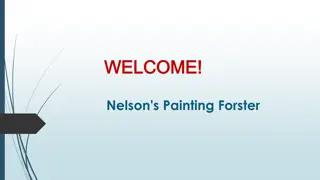Comprehensive Guide to Acrylic Painting Tools, Tips, and Techniques
Explore the history of acrylic paints, the basics of acrylic painting, essential tools like brushes, paintbrush construction and care tips, as well as techniques such as color blocking and creating transparent effects with acrylics. Enhance your acrylic painting skills with this detailed guide.
Download Presentation

Please find below an Image/Link to download the presentation.
The content on the website is provided AS IS for your information and personal use only. It may not be sold, licensed, or shared on other websites without obtaining consent from the author. Download presentation by click this link. If you encounter any issues during the download, it is possible that the publisher has removed the file from their server.
E N D
Presentation Transcript
Acrylic Painting Tools, Tips and Techniques
Acrylic PaintBasics History Developed in the late 1940s. In the 1950's, the water-based acrylics were developed. They became popular in the 1960's when pop artists used them, such as Andy Warhol. Other art styles that explored this medium were photorealism and OpArt Andy Warhol- Portrait Your footer here - 2
Acrylic PaintBasics Contents Acrylic paints are made from pigment, water and an acrylic binder, which forms a hard, clear film as the water evaporates. It is this transparent film, reflecting light from thepigment inside it, that gives acrylic color itsbrilliance. Acrylics are water-soluble, non-toxic, easy to clean, and dry quickly. They can be used opaque (no light shows through) either through thick paint application or by adding white.They can be diluted with water and painted so they are transparent (light shows through). Drawing and PaintingII - 3
Acrylic PaintTools Brushes Acrylic paintbrushes come in various shapes & sizes. Never use one brush size for an entire painting Drawing and PaintingI - 4
Understanding Paintbrush Construction &Use A paintbrush is made up of three parts: Thehandle, the ferrule, and tuft (brush hairs or bristles). - 6
Care of AcrylicBrushes Always clean your brush immediately after use. If color has dried on the brush, it is ruined. Do not stand a brush on its handle- will cause water to leak down into the ferrule, loosening the glue that holds the bristles together. Never leave brushes standing on their bristles to dry- they will dry to that shape. 6 Drawing and PaintingII -
Techniques ColorBlocking under-painting in large flat shapes to lay out composition. After color blocking start painting details in the background (like the sky) and then paint the next ground when finished completely- work from the back to the front. Keep it simple 13 -
Techniques Transparent(watercolor) By thinning acrylics with water have similar effects of transparent watercolor. 8 -
Techniques Wet-on-Wet mixing two wet colors/values of paint on canvas to help blend/gradient colors Acrylics dry fast- to help keep paint moist, spritz with water to slow the drying process down. 9 Drawing and PaintingII -
Techniques Impasto thick applied paint- usually done with a pallet knife 10 -
Techniques HardEdge Creating a clean, straight edge between objects (colors/values) 11 -
Techniques Scumbling The application of broken color; letting the color underneath to show through. using a dry brush to create stippling or texture- Dip tips of dry brush in thin layer of paint and either pounce the brush on the canvas or sweep the brush across the canvas to create different textures. 12 -
Mixing Neutrals: Instead of using black and brown out of the of the bottle you should mix them from Primary colors. BLACK: Warm black: start with red and add green Cool black: start with blue and add orange about 90% base color and 10% complement BROWN: about 50% base color and 50% complement Warm Brown: base is red and little less green Cool Brown: Base Blue and little less orange 22 -
Helpful Hints: : START from the BACKGROUND and work your way forward. This will keep you from having to paint in between little details- its faster to work thisway!! Diffuse edges (blend) with a dry brush by dabbing lightly. Acrylics become darker in tone as they dry, so remember to allow for this effect when mixing your colors. Acrylics are resistant to water once dry, which means they can be over-painted without disturbing the previous color. Once dry, colors cannot be dissolved with a damp brush. 21 -
PreliminaryWork: v In your sketchbook try to replicate the picture of this pear using the color blocking technique. First do a simplified color blocked underpainting focusing on value. Then do a slightly transparent (thin with water) top layer to smooth out your transitions. : 23 -
Painting techniqu Painting technique es to consider s to consider Impasto ColorBlocking Wet-on-Wet Scumbling Hard Edge Transparent
Create Your Palette Create Your Palette Color match photo reference and mix enough paint for entire painting
REMEMBER: NO DETAILS AT THIS STAGE! WRAP PAINTING background colors should extend onto all sides of canvas through entire process SKETCH BASIC shapes onto canvas SKETCH BASIC shapes onto canvas & BLOCK IN first layer & BLOCK IN first layer (2 (2 3 colors) 3 colors)
REMEMBER: PAY ATTENTION TO BRUSH STROKES. Choose correct techniques: Should you be using wet-on-wet to blend or dry brush to add texture? Both? Add shadows Add shadows THROUGHOUT THROUGHOUT
Add highlights, mid-tones throughout DIRECTION OF BRUSH STROKES MATTERS!
Add more detail.and more detailand more detail Consider painting transparently on top layers, allowing under layers to show through. Also, use different size brushes.
































